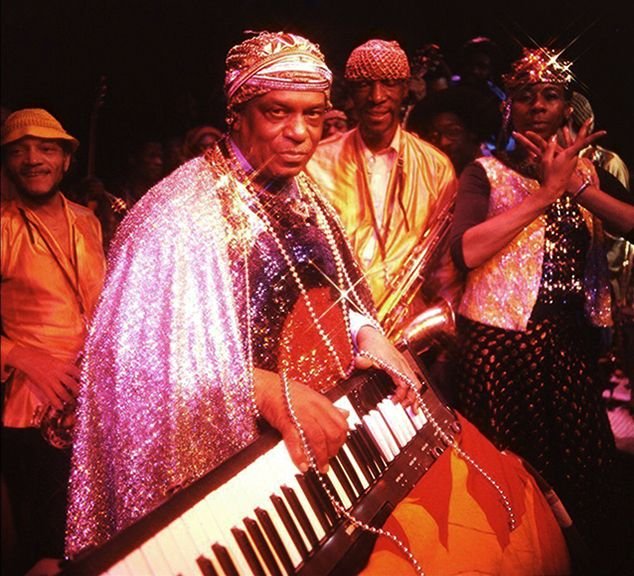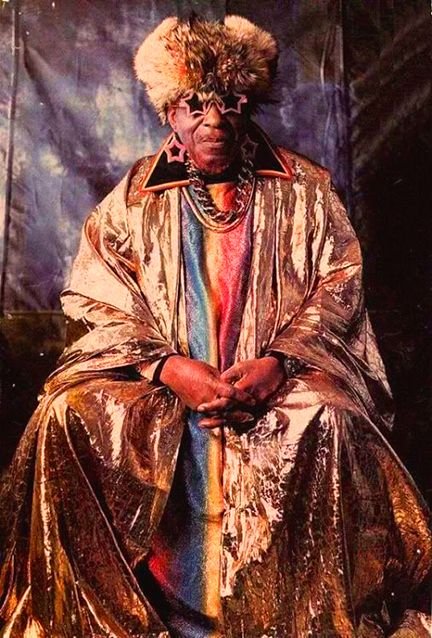Other Worlds
Danny Davis (saxo alto, flauta), Marshall Allen (saxo alto, flautín, campanas, platillos en forma espiral), John Gilmore (saxo tenor, timbales), Pat Patrick (saxo baríton, timbales), Chris Capers (trompeta), Teddy Nance (trombón), Bernard Pettaway (trombón bajo), Robert Cummings (clarinete bajo, caja china), Sun Ra (piano, marimba, celeste eléctrico, timbales), Ronnie Boykins (contrabajo) y Jimhmi Johnson (batería, percusión, timbales). Extraído del álbum The Heliocentric Worlds of Sun Ra, Volume One (1965).
En 1952 Sun Ra formó el grupo Space Trio y cambió legalmente su nombre por Le Sony’r Ra para poder proclamar su origen cósmico. Después formó con Alton Abraham un sello discográfico independiente llamado El Saturn Records con el que grabó varios álbums y fundó la Sun Ra Arkestra, que tenía normalmente de diez a treinta miembros. Al principio tocaban bebop, pero a finales de los años cincuenta, Ra se abrió a las influencias de otras culturas utilizando primitivos teclados eléctricos y tocando música libre mucho antes de que apareciera el free jazz. También empezaron a usar los excéntricos trajes relacionados con la civilización egipcia y la ciencia ficción por los que se dieron a conocer. En 1961, Ra se trasladó con su grupo a Nueva York, donde todos convivían en un mismo edificio como una comunidad religiosa en la que la libertad creativa estaba unida a una férrea disciplina. Allí es donde ese mismo año grabaron The Futuristic Sounds of Sun Ra y en 1965 The Heliocentric Worlds of Sun Ra, Volume One y Volume Two. Estos dos últimos álbums son completamente improvisados, pero hay un asombroso sentido de estructura. Existe una dicotomía entre la libertad que Sun Ra da a sus músicos y su capacidad de dictar la forma y el estado de ánimo de cada tema. Al igual que el pianista y director de big band Duke Ellington, era capaz de obtener los resultados que quería con solo una mirada o un movimiento con la cabeza.
In 1952 Sun Ra formed the group Space Trio and legally changed his name to Le Sony’r Ra in order to proclaim his cosmic origin. He later formed with Alton Abraham an independent record label called El Saturn Records with which he recorded several albums and founded the Sun Ra Arkestra, which normally had ten to thirty members. At the beginning they played bebop, but in the late 1950s, Ra became receptive to the influences of other cultures using early electric keyboards and playing free music long before free jazz appeared. They also started to wear the eccentric clothing related to Egyptian civilization and science fiction for which they made themselves known. In 1961, Ra went with his group to New York, where they all lived together in the same building as a religious community in which creative freedom was linked to an iron discipline. That’s where they recorded that same year The Futuristic Sounds of Sun Ra and in 1965 The Heliocentric Worlds of Sun Ra, Volume One and Volume Two. These last two albums are entirely improvised, but there is an awesome sense of structure. There is a dichotomy between the freedom Sun Ra gives to his musicians and his ability to determine the style and spirit of each track. Like pianist and big band leader Duke Ellington, he was able to get the results he wanted with just a glance or a nod.
 Sun Ra
Sun Ra
Fuente
 Cubierta de The Futuristic Sounds of Sun Ra
Cubierta de The Futuristic Sounds of Sun Ra
Fuente
Las actuaciones en directo de la Sun Ra Arkestra incluían remolinos percusivos, aterradores efectos electrónicos, ecos inconexos de rhythm and blues, elementos de música asiática y africana, disonancias y atonalidad. A partir de marzo de 1966, y durante un año y medio, el grupo tocó todos los lunes por la noche en el club de jazz Slug’s Saloon, lo que aumentó sus fans entre los beatniks, los primeros seguidores de la psicodelia y los críticos musicales. Aunque había opiniones opuestas sobre su música, fue elogiado por el trompetista Dizzy Gillespie y el pianista Thelonious Monk. En 1968 el edificio que tenían alquilado se puso en venta y se marcharon a Philadelphia. Allí Sun Ra compró una casa que se convirtió en el lugar de residencia de la banda hasta su muerte. Ese mismo año la Sun Ra Arkestra realizó su primera gira por la costa oeste de los Estados Unidos, exponiendo sus elaboradas actuaciones ante hippies y Deadheads. En 1969, Ra apareció en la portada de la revista Rolling Stone, lo cual aumentó su popularidad. En 1970, el grupo hizo una gira por el Reino Unido, Alemania y Francia, y continuó tocando en Europa durante muchos años.
The Sun Ra Arkestra’s live performances included percussive whirlpools, frightening electronic effects, unrelated echoes of rhythm and blues, elements of Asian and African music, dissonances and atonality. Starting in March 1966, and for a year and a half, the group played every Monday night at Slug’s Saloon jazz club, which increased their fans among the beatniks, early psychedelia followers and musical critics. Although there were opposed opinions about his music, he was praised by trumpeter Dizzy Gillespie and pianist Thelonious Monk. In 1968 the building they rented went on sale and they left for Philadelphia. There Sun Ra bought a house that became the band’s home until his death. That same year the Sun Ra Arkestra made their first tour of the west coast of the United States, showing their elaborated interpretations to hippies and Deadheads. In 1969, Ra appeared on the cover of Rolling Stone magazine, which increased his popularity. In 1970, the group toured the United Kingdom, Germany and France, and continued to play in Europe for many years.
 Sun Ra
Sun Ra
Fuente
La composición comienza con Ra tocando el piano de forma desordenada y caótica representando la violencia que hay en el mundo. A continuación el resto de la banda aparece envuelta en un torbellino de sonidos cacofónicos sin reglas ni limitaciones. Después Ra se vuelve a quedar solo golpeando las teclas del piano sin contemplaciones. Luego vuelve el grupo de manera frenética y delirante hasta que terminan de forma repentina.
The composition begins with Ra playing the piano in a disordered and chaotic manner representing the violence that exists in the world. Then the rest of the band arises wrapped in a whirlwind of cacophonous sounds without rules or limitations. After that, Ra is left alone again hitting the keys of the piano without hesitation. Next the group returns in a frenetic and delirious way until they end abruptly.
 Sun Ra
Sun Ra
Fuente
Translated with the help of DeepL
Fuente

The Cosmos
Danny Davis (saxo alto, flauta), Marshall Allen (saxo alto, flautín, campanas, platillos en forma espiral), John Gilmore (saxo tenor, timbales), Pat Patrick (saxo baríton, timbales), Chris Capers (trompeta), Teddy Nance (trombón), Bernard Pettaway (trombón bajo), Robert Cummings (clarinete bajo, caja china), Sun Ra (piano, marimba, celeste eléctrico, timbales), Ronnie Boykins (contrabajo) y Jimhmi Johnson (batería, percusión, timbales). Extraído del álbum The Heliocentric Worlds of Sun Ra, Volume One (1965).
Ra toca una nota con el celeste eléctrico y a continuación Boykins hace un solo con el contrabajo con arco angustiado y ansioso hasta que Ra y Allen se unen a él. Entonces, Allen toca un pasaje que empieza siendo melodioso, pero termina desestructurado. A continuación los tres se detienen y entra Johnson utilizando diversos instrumentos de percusión. Después le toca el turno a Ra con el electric celeste interpretando un discurso original e inventivo, aunque algo extraño. Luego vuelve Boykins, que sigue tan nervioso como antes, acompañado de Patrick con el timpani. De repente entra todo el grupo con Ra tocando el piano y se va desvaneciendo hasta dejar solo a Johnson durante un rato, pero vuelve con fuerzas renovadas. Luego Ra se queda solo de nuevo, pero esta vez con el piano, presentando una línea melódica compleja y acelerada. Después el grupo regresa de forma tan desbocada como siempre para concluir la composición.
Ra plays a note with the electric celeste and then Boykins makes an anguished and anxious solo with the double bass with bow until Ra and Allen join him. Next, Allen plays a passage that begins being to be melodious, but ends up unstructured. Afterwards, the three of them stop and Johnson enters using various percussion instruments. Then it’s Ra’s turn with the electric celeste performing an original and inventive speech, although something strange. Later Boykins returns, still as nervous as before, accompanied by Patrick with the timpani. All of a sudden the whole group enters with Ra playing the piano and fades out to leave Johnson alone for a while, but later returns with renewed strength. Then Ra is left alone again, but this time with the piano delivering a complex and accelerated melodic line. At the end, the group comes back as unbridled as ever to conclude the composition.
 Fuente
Fuente








¡Enhorabuena!
✅ Has hecho un buen trabajo, por lo cual tu publicación ha sido valorada y ha recibido el apoyo de parte de CHESS BROTHERS ♔ 💪
♟ Te invitamos a usar nuestra etiqueta #chessbrothers y a que aprendas más sobre nosotros.
♟♟ También puedes contactarnos en nuestro servidor de Discord y promocionar allí tus publicaciones.
♟♟♟ Considera unirte a nuestro trail de curación para que trabajemos en equipo y recibas recompensas automáticamente.
♞♟ Echa un vistazo a nuestra cuenta @chessbrotherspro para que te informes sobre el proceso de curación llevado a diario por nuestro equipo.
🏅 Si quieres obtener ganancias con tu delegacion de HP y apoyar a nuestro proyecto, te invitamos a unirte al plan Master Investor. Aquí puedes aprender cómo hacerlo.
Cordialmente
El equipo de CHESS BROTHERS
Muy buena tematica y un trabajo muy completo e investigado. Felicitaciones por tu post!!!